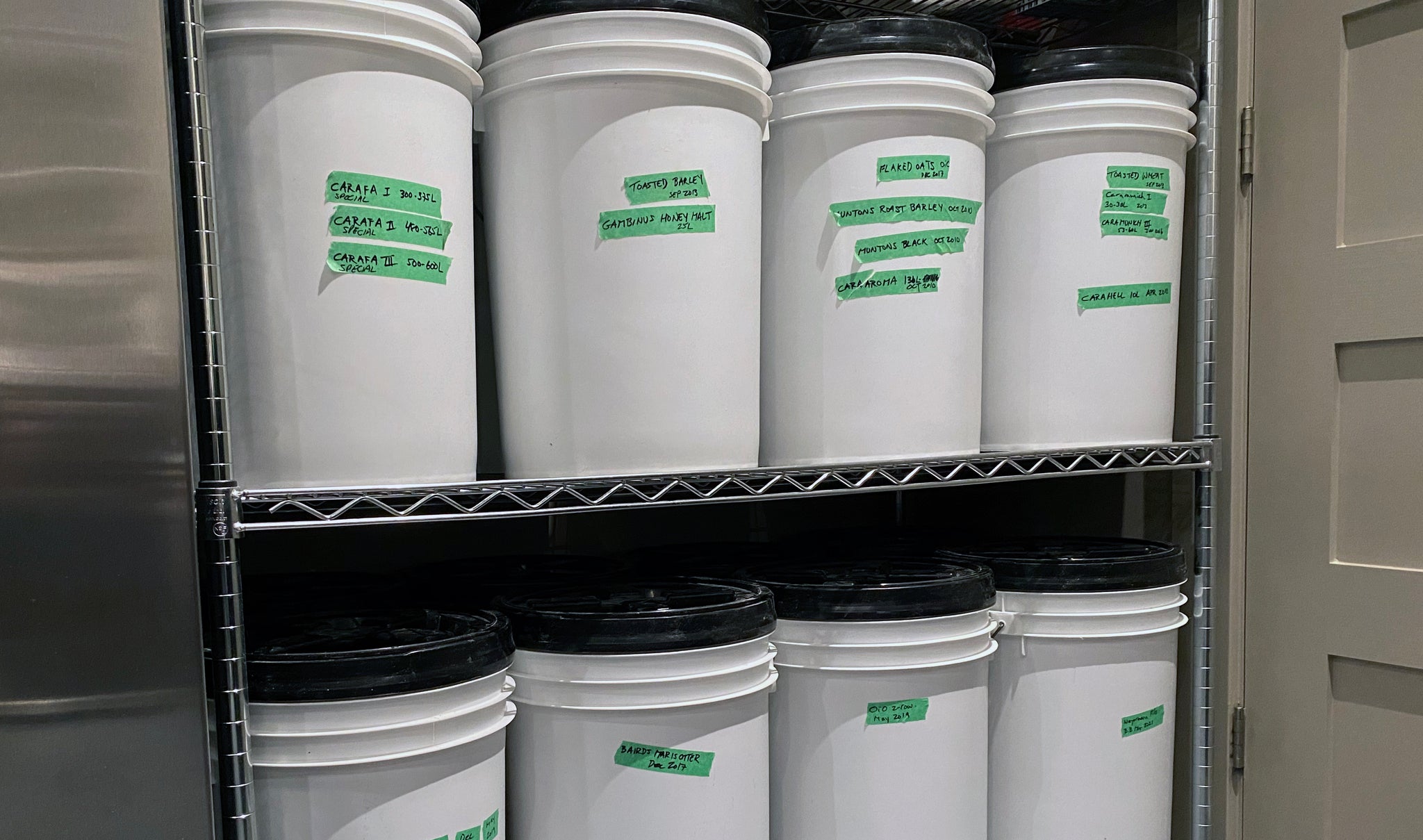Storing Grain
- Introduction
- Parts and tools
- Food grade buckets with Gamma Seal lids
- Vittles Vault containers
- Speciality grain
- Pictures / Videos

Introduction
One of the most important factors in keeping malted grain (malt) fresh as long as possible is to keep it in a completely sealed / airtight container of some sort. The container must be airtight if the grain is to be kept as fresh as possible, especially past the best before date.
The 50-55 pound sacks that bulk un-milled grain is shipped in are not airtight by any stretch of the imagination and if stored this way the grain should be used within a few months (refer to the manufacturer recommended storage conditions and best before dates). Stored under ideal conditions in an airtight container however, un-milled grain can stay fresh well beyond the manufacturer best before date.
Generally speaking the higher the degree of kilning applied, the longer the malt will stay fresh. When stored in airtight containers, we try to use all base malts within one year and most others within a few years. Heavily kilned malts like chocolate malt and black (patent) malt seem to retain their flavours forever.
It is best to store all malt in a cool, dry place away from sunlight and heat.
Airtight storage allows us to purchase most of our grain in bulk as it is considerably less expensive than buying by the pound. This is especially true for the base grains that will often make up 70-100% of any given recipe.
The base grains we always have on hand and purchase in bulk include:
- Domestic 2-row malt (1.8-2.0L) (for North American ales and lagers)
- German pilsner malt (1.5-2.1L) (for German and European lagers, some specialty ales)
- British Maris Otter malt (2.5-4.0L) (for English style ales)
- Wheat malt (1.5-2.4L) (for wheat beers)
Purchasing other specialty grains in bulk doesn't always make sense as they usually only make up a small percentage of any given recipe. It's not uncommon to use 1-2 pounds of crystal malt or only a few ounces of highly kilned malt per 10 gallons of beer produced. Unless you intend to split a 50 pound sack with other brewing friends, it's best to purchase specialty grains by the pound.
The speciality grains we use most often include:
- Carapils or Carafoam malt (1.4-2.9L) (adds body, foam retention and beer stability without influencing colour or flavour)
- German dark Munich malt (8-10L) (increases body, aroma, malt sweetness and has a slight biscuit flavour - is technically a base malt too)
- German Vienna malt (3-4L) (best described as a lighter version of Munich Malt - is technically a base malt too)
- Crystal malt 40L (adds sweet mild caramel flavour and golden colour)
- Crystal malt 60L (adds caramel flavour and a deep golden to red colour)
- Crystal malt 120L (adds heavier caramel/toffee/nutty flavour and a red to deep red colour)
Others exist of course, but these are the ones we use the most.
Parts and tools
Purchasing through our affiliate links helps support our site at no extra cost to you. We thank you!
Food grade buckets with Gamma Seal lids
 We use 6 gallon 12" diameter food grade buckets with Gamma Seal lids keep grain fresh
We use 6 gallon 12" diameter food grade buckets with Gamma Seal lids keep grain fresh
 Gamma Seal lid close-up
Gamma Seal lid close-up
We store our grain in in 6 gallon 12" diameter food grade buckets. Two 6 gallon buckets hold exactly one 50-55 pound sack of grain.
While some buckets may come with lids, most are not airtight and/or are an absolute pain to open. We use and recommend Gamma Seal lids instead of stock lids. These lids are used for all sorts of applications including canoers who need waterproof and airtight containers. Snap the adapter onto the bucket using a rubber mallet, and then simply spin on the removable lid to create an airtight seal. They are very easy to use and no special tools are needed to open - simply spin the lid on and off. Specially engineered gaskets ensure that the lid and adapter are properly sealed to guarantee airtight protection. Gamma Seal lids are available in different colours allowing for a quick and easy reference by using one colour for base malts, another for crystal, and so forth.
This combination of 6 gallon 12" food grade buckets and Gamma Seal lids is by far the most inexpensive and convenient way we've found to store large quantities of grain in a completely airtight manner. After more than 10 years of use the lids are still extremely easy to open and close by hand and create a perfect seal every time.
One 50-55 pound sack fills two 6 gallon 12" buckets which we label with green painters tape and a Sharpie permanent marker. We keep approximately 20 buckets on shelves in our brewery, enough to brew any beer imaginable, any time we want.
Vittles Vault Containers
The Vittles Vault line of pet food storage containers are also an excellent choice for storing grain. They come in various shapes and sizes for up to 80lbs of storage per container. Stackable versions are available for easy access. Gamma Seal lids are included and provide a waterproof / airtight seal.
We've seen many other containers (mostly cheap pet food storage containers) that claim to be sealed or airtight but upon closer inspection they do not create nice airtight seals as promised. Try this simple test: Walk into the area where you store your grain and if you smell grain at all (even just a little bit) when up close or when you squeeze or press on the container or lid, your storage system is not airtight. A plastic lid, even if it has a foam lining, snapped to a plastic body will not form an airtight seal. Over time air will circulate causing the grain to go stale at an increased rate.
Specialty Grain
 Specialty grain is first placed in Ziploc double zipper gallon storage bags
Specialty grain is first placed in Ziploc double zipper gallon storage bags
Specialty grain is also stored in our well-sealed buckets, but the grain is first placed in Ziploc double zipper gallon storage bags and labelled with a Sharpie permanent marker. Each gallon bag holds approximately 4 pounds of grain. We then label the outside of the buckets as well with green painters tape so that there's no need to go hunting.
 Specialty grains waiting to be sealed up in 6 gallon food grade buckets
Specialty grains waiting to be sealed up in 6 gallon food grade buckets
Pictures / Videos
Interested in seeing what we're brewing right now? Follow us on Instagram for pictures and videos of our brewing activities as they happen.















